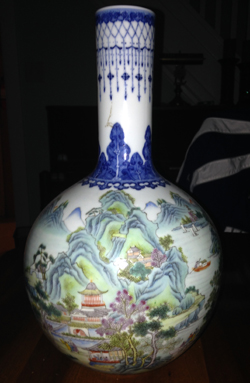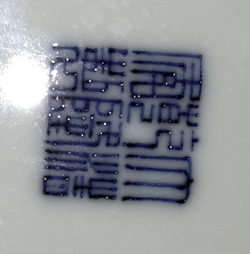 |
|
|||
 |
 |
|||
Copyright © Harry Rinker, LLC 2016 Questions
and Answers
QUESTION: I have a 13 1/2 inches high Chinese vase that my father, J. R. Rickenback, Jr., received during his service in World War II. The base has a bulbous body with an elaborate multi-colored mountain landscape scene. There is a large extended cylindrical neck ANSWER: I have reached a point in my collecting career where I prefer to buy objects with a personal story. More often than not, the story adds no financial value. I do not care. The story personalizes the object, a value that transcends money. Japanese ceramic marks are difficult to interpret. Marks were copied long after the end of the dynasty in which they originated. Given your story, it is safe to assume the object predates 1945. The internet is home to Jan-Erik Nilsson’s The form, shape, and pattern suggest your vase dates from the early to mid-twentieth century, perhaps made within a decade or two of the time when your father acquired it. The hand painted scene and decoration is extremely well done, much better than most export pieces. The value of your vase is between $125.00 and $150.00. QUESTION: I own 15 bottles in the Wheaton Great American Series. One of the bottles features an image of Martin Luther King. All the bottles are in their period boxes. What is my set worth? –J, Pottsville, PA ANSWER: Dr. Theodore C. Wheaton, a physician and businessman, founded the Wheaton Glass Company, located in Millville, New Jersey in 1883. The company’s main focus was the production of pharmaceutical glassware. In 1888, Wheaton established a small factory to manufacture glass bottles near the Millville border. A switch to automated machinery saved the company during the Depression. Company leadership remained in the hands of the Wheaton family for much of its history. Theodore C. Wheaton was succeeded by his son Frank Wheaton, Senior, who remained associated with the company until his death at age 102 in 1983. Frank Wheaton, Jr., assumed leadership in 1966. Frank, Jr., founded Wheaton Village, a non-profit living museum and artisan colony in Millville. After a board fight in 1991, Frank, Jr., was succeeded by George J. Straubmuller III, who was married to the granddaughter of T. C. Anderson. Wheaton Glass, a division of Wheaton Industries, began producing commemorative bottles, decanters, and flasks in 1967. The company’s Presidential bottle series was launched in 1976 with a John F. Kennedy bottle. The reverse contained a quotation from the president. Other series followed: Great Americans in 1969, utilizing a flask bottle; Astronauts in 1971; Patriots in 1972; and, American Military Leaders in 1974. Initially, these bottles were sold through Wheaton franchised dealers and by mail order from the Collectors Guild and “Bathsheba’s Bottle Book.” In 1974, the Wheaton Historical Association assumed control of the series. Production runs were limited to a maximum of 5,000, a reduction in number from earlier production runs. Post-1974 bottles were made by a semi-automatic machine rather than the automated production process employed by Wheaton Industries. In 1976, Millville Art Glass Company took over production of the President series and the Christmas series, marketing the finished bottles under the “Wheaton” label. The 1990s was a difficult time for Wheaton Industries. Algroup, a Swiss firm, acquired the company which was subsequently acquired by Alcan of Canada in 2000. In 2002, the molded glass operation became The Glass Group, Inc. When it filed for bankruptcy in the summer of 2005, India-based Gujarat Glass and Kimble Glass, a Gerresheimer subsidiary, purchased the assets. Amcor Packaging of Australia owns the glass tubing and plastic division. Wheaton Science Products (also known as Wheaton Industries) was established in 2005. DURAN Group GmbH, a Germany company, bought Wheaton Industries in 2015. See: https://en.wikipedia.org/wiki/Wheaton_Industries for a complete history. The first question to ask when valuing any set is whether it is complete. Your set is not. The Great American series had 18 bottles, 17 with a teardrop shape and one a round decanter shape (James E. Carter, Jr.). All had an iridescent finish except for the Keller bottle (ruby) and Edison bottle (cobalt). The full list of bottles is: Thomas Alva Edison, Alexander Graham Bell, James E. Carter, Jr., Benjamin Franklin, Rev. Billy Graham, Charles Evans Hughes, John Paul Jones, Robert Kennedy, Martin Luther King, Jr., Helen Keller, Robert E. Lee, Charles A. Lindberg, Douglas MacArthur, George G. Patton, Paul Revere, William Penn Adair Rogers, Betsy Ross, and, Mark Twain. Collector interest in Wheaton commemorative/collector edition bottles is minimal. Crossover (theme) collectors usually pay more than Wheaton bottle collectors. “Buy It Now” prices on eBay for Great American series bottles in their period boxes range from $6.50 to $20.00 depending on the personality. One seller was asking $40.00 for six bottles in their period boxes. Several sellers, typical for eBay “Buy It Now” sellers, were asking higher than normal shipping costs to raise their profit margin. Sell your 15 bottles as a lot. Do not allow a potential buyer to cherry pick the best bottles. Any offer over $75.00 for the 15 bottles makes you a winner. I realize that this is less than you paid for the bottles new; but, it is more money than you have now. QUESTION: Over 25 years ago, my father-in-law gave me a “Glenn Miller Limited Edition” (#QQ293) album with a printed biography of Miller inside that he purchased in the late 1940s. The album has 14 RCA Victor 45 EP (extended play) records. The biography and song selections were compiled by George Frazier, RCA Victor’s Coordinator of Special Projects. The album measures 8 x 9 inches. The book is in below average condition. The records are in excellent condition. Can you provide me with a value and the marketability of this collection? – TN, Hollidaysburg, PA, Email Question ANSWER: When I lived at The School (former Vera Cruz [PA] Elementary School), I had a Wurlitzer 2600 jukebox in the living room. Believing that music died when Glenn Miller’s plane went down, the music selection on the jukebox contained many Miller records. I actually owned the album about which you are inquiring. I bought it for $30.00, primarily for access to the records. In 2016, $30.00 is a high price. The standard “Buy It Now” price on eBay ranges from $15.00 to $20.00. There are multiple reasons for the low prices. First, few own a 45 rpm record player, albeit some of the older turntables allow for 45 rpm play. Second, the younger generations have no interest in the Glenn Miller sound. If they want an example, they will buy a remastered CD. Hopefully, you own a phonograph that still can play these records. If not, read the bio and smile. For those over 75, Glenn Miller’s music has never died.Harry L. Rinker welcomes questions from readers about
collectibles, those mass-produced items from the twentieth and twenty-first centuries.
Selected letters will be answered in this column.
Harry cannot provide personal answers.
Photos and other material submitted cannot be
returned.
Send your questions to: Rinker on Collectibles, 5955 Mill
Point Court SE, Kentwood, MI 49512.
You also can e-mail your questions to
harrylrinker@aol.com.
Only e-mails containing a full name and mailing address
will be considered.
You can listen
and participate in
WHATCHA GOT?, Harry’s
antiques and collectibles radio call-in show, on Sunday mornings between 8:00 AM
and 10:00 AM Eastern Time.
If you
cannot find it on a station in your area,
WHATCHA GOT?
streams live on the Internet at www.gcnlive.com.
SELL, KEEP OR TOSS?: HOW TO DOWNSIZE A HOME,
SETTLE AN ESTATE, AND APPRAISE PERSONAL PROPERTY
(House of Collectibles, an imprint of Random House Information Group, $17.99),
Harry’s latest book, is available at your favorite bookstore and via
www.harryrinker.com.
|
||||
 with a blue latticework design. My father, who is now 93, tells this story. When my dad was in Hong Kong, he and a group of his naval buddies decided to leave the ship and take a walk through the city. During their walk, they heard a violin playing. Because my dad was a musician, they stopped to listen. The violinist was a student who was receiving a lesson. The instructor saw them and asked if one of them was a violinist. My dad said, “No. But, I play piano and know that number.” The instructor invited the sailors into his house. My dad accompanied the violinist. The instructor was thankful and invited my dad to have dinner with his family the following evening. When dinner was finished, the instructor insisted that my dad take the vase with him. My dad thought the vase was ugly. He took it as a courtesy and safely transported it home to Shillington, Pennsylvania. The vase has always intrigued me. Since I spent four years in Japan while I was in the Air Force, I have a slight interest in Oriental art. Although the vase came from Hong Kong, the mark on the bottom looks Korean. What light can you shed on its origin and value? – KN, West Lawn, PA, Email Question.
with a blue latticework design. My father, who is now 93, tells this story. When my dad was in Hong Kong, he and a group of his naval buddies decided to leave the ship and take a walk through the city. During their walk, they heard a violin playing. Because my dad was a musician, they stopped to listen. The violinist was a student who was receiving a lesson. The instructor saw them and asked if one of them was a violinist. My dad said, “No. But, I play piano and know that number.” The instructor invited the sailors into his house. My dad accompanied the violinist. The instructor was thankful and invited my dad to have dinner with his family the following evening. When dinner was finished, the instructor insisted that my dad take the vase with him. My dad thought the vase was ugly. He took it as a courtesy and safely transported it home to Shillington, Pennsylvania. The vase has always intrigued me. Since I spent four years in Japan while I was in the Air Force, I have a slight interest in Oriental art. Although the vase came from Hong Kong, the mark on the bottom looks Korean. What light can you shed on its origin and value? – KN, West Lawn, PA, Email Question.